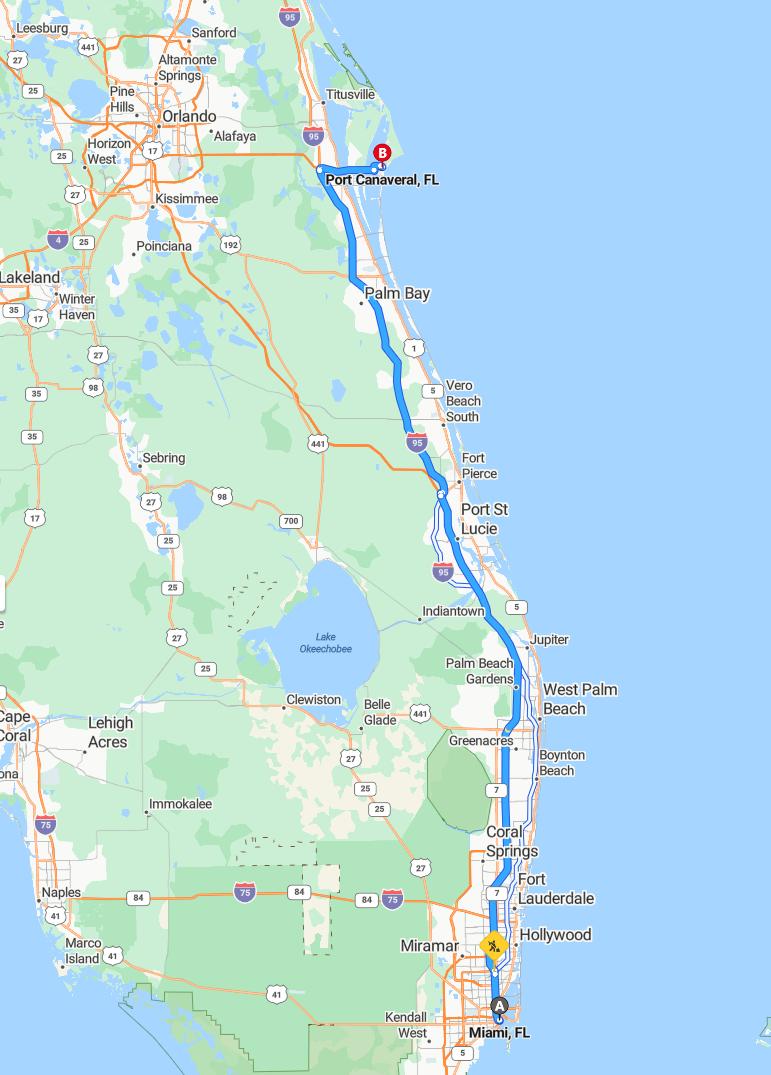Distance and estimated driving time
The drive from Miami to Port Canaveral covers approximately 213 miles and typically takes around 3 hours and 11 minutes. The most common route involves traveling along I-95 North and then switching to FL-91 North, ensuring a straightforward journey. Given the distance, travelers should plan for possible traffic delays, especially during peak travel times. This route offers a direct connection between the southern and eastern coast of Florida, making it a convenient option for travelers heading to Port Canaveral.
Driving route
Embarking on a road trip from Miami to Port Canaveral, travelers will journey through a diverse array of vibrant Florida communities. Starting in Miami, the route passes through Miramar, Hollywood, and Fort Lauderdale, offering a glimpse of South Florida's bustling urban life and scenic coastal areas. Continuing north, drivers encounter the charming towns of Boynton Beach, West Palm Beach, and Palm Beach Gardens, known for their luxurious estates and cultural attractions. As the journey progresses, the route leads through Jupiter, Indiantown, and Port St. Lucie, revealing Florida's natural beauty and red-orange sunsets. The final stretch takes travelers past Fort Pierce, Vero Beach, Palm Bay, Melbourne, and Titusville, culminating at the bustling Port Canaveral, a premier cruise port and gateway to adventure.

Best time to travel
The optimal time to travel from Miami to Port Canaveral is during the fall and winter months, from October to February, when the weather is milder and less humid. Avoiding peak summer months, especially July and August, can help travelers steer clear of heavy traffic and higher temperatures. Traveling early in the week or during off-peak hours also reduces time spent in congestion along major stops like Fort Lauderdale and West Palm Beach. Planning your trip outside of major holidays and school vacation periods ensures a smoother journey with less crowded highways and attractions.
Traffic conditions and peak hours
Driving from Miami to Port Canaveral involves navigating several busy areas with varying traffic conditions. Peak hours typically occur between 7:00-9:00 a.m. and 4:00-7:00 p.m., especially around Miami, Fort Lauderdale, West Palm Beach, and Melbourne, where congestion is common. Traffic tends to lighten during midday and late evenings, making these times preferable for smoother travel. Travelers should plan accordingly to avoid delays, particularly during weekends and holiday weekends when roads can become especially crowded.
Highway and local road options
Traveling from Miami to Port Canaveral offers a variety of highway and local road options to suit different preferences. The most direct route typically involves taking Interstate 95 north, providing a fast and efficient journey through major cities such as Fort Lauderdale, West Palm Beach, and Port St. Lucie. Along the way, travelers can choose to explore local roads and scenic routes through towns like Hollywood, Boynton Beach, Jupiter, and Vero Beach for a more leisurely experience. Combining highways with local roads allows for flexibility to enjoy sightseeing, stopovers, or visits to smaller communities en route to Port Canaveral.
Rest stops and scenic viewpoints
As you drive from Miami to Port Canaveral, there are numerous rest stops and scenic viewpoints along the route to enhance your journey. In Fort Lauderdale and West Palm Beach, you can find park areas and waterfront parks perfect for relaxing and enjoying the scenery. Vero Beach and Palm Bay offer picturesque coastal vistas, with some parks and nature preserves suitable for quick breaks and sightseeing. Additionally, Titusville, near Port Canaveral, features beautiful views of the Indian River and opportunities to witness the Florida coastline's natural beauty.
Road safety tips and precautions
When driving from Miami to Port Canaveral, it's essential to prioritize road safety by staying alert and avoiding distractions. Regularly checking your vehicle's condition, including tires and brakes, helps prevent breakdowns and accidents along the route. Always adhere to posted speed limits and maintain a safe following distance, especially through busy areas like Fort Lauderdale and West Palm Beach. Additionally, plan your stops at designated rest areas to avoid fatigue, and ensure you have all necessary documents and emergency supplies for a smooth journey.
Parking facilities at Port Canaveral
Port Canaveral offers a variety of parking options to accommodate visitors' needs, including secure, spacious garages and surface lots. The parking facilities are designed for convenience, with easy access to cruise terminals and nearby attractions. Parking rates are competitive, and there are options for both short-term and long-term parking. Overall, Port Canaveral's well-maintained parking facilities ensure a stress-free start and end to your cruise experience.
Weather forecast on travel day
The weather forecast for the day of travel from Miami to Port Canaveral predicts mostly clear skies with mild temperatures, ensuring a smooth drive along the route. Travelers can expect minimal rain and light breezes, particularly in the southern parts of the journey, such as Miami, Hollywood, and Fort Lauderdale. As the route progresses northward through cities like West Palm Beach, Jupiter, and Port St. Lucie, conditions are expected to remain consistent, with comfortable weather. Overall, the forecast suggests an ideal day for a drive, with no significant weather disruptions anticipated along this scenic coastal route.
Alternative transportation options
Travelers between Miami and Port Canaveral have several alternative transportation options beyond driving. Bus services like Greyhound and FlixBus offer convenient, affordable routes along the route with multiple stops, making them suitable for budget-conscious travelers. Amtrak's Silver Service provides a scenic train journey from Miami to nearby destinations, though it does not go directly to Port Canaveral, requiring additional ground transportation. Additionally, those seeking rapid transit can consider private shuttle services, ride-sharing apps, or rental bikes in select cities for shorter segments, providing flexible and eco-friendly alternatives to driving.
